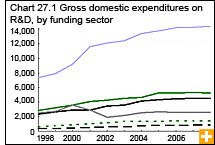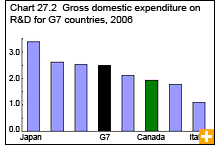Common menu bar links
Science and technology
Archived Content
Information identified as archived is provided for reference, research or recordkeeping purposes. It is not subject to the Government of Canada Web Standards and has not been altered or updated since it was archived. Please contact us to request a format other than those available.
Scientific research and innovation can improve our lives and make Canada a more competitive country. Countries with a well-supported science sector can get ahead economically by being the first to reap the benefits of new scientific discoveries and new technologies. Science and technology also employs hundreds of thousands of talented Canadians in private firms, government laboratories and university research programs.
How science is funded
How much a country spends on scientific research and development (R&D) is a good indicator—probably the best available— of how much research and innovation is taking place.
This indicator, gross expenditures on research and development (GERD), refers to all money spent on R&D in a given year. GERD is a key benchmark, not unlike gross domestic product (GDP) for the whole economy: like GDP, GERD is used for making national and international comparisons of R&D activity.
Canada’s anticipated domestic spending on R&D totalled $29.1 billion in 2008, compared with $16.1 billion in 1998. Businesses were expected to fund $14.4 billion; the federal government, $5.3 billion; and the higher education sector, $4.5 billion. Provincial governments, the private non-profit sector and the foreign sector funded smaller amounts.
Where the funding is spent
R&D performance is a measure of which sector did the work, as opposed to the source of funding for the work. Business enterprises were expected to account for $16.3 billion worth of work, more than half of total R&D performance. The higher education sector was expected to account for $9.8 billion, or one-third.
Combined, these two sectors were expected to perform 90% of Canada’s R&D work in 2008, as they have since 2003.
Ontario (excluding the Ottawa region) accounted for 44% of GERD spending among the provinces in 2006, and Quebec (excluding Gatineau), 26%.
How we rank in the world
Canada’s 2006 GERD spending comprised 1.9% of GDP, compared with the average among G7 nations of 2.5%. The United States spent 2.7% of GDP on GERD, the United Kingdom, 1.8%, Germany, 2.5%, and France, 2.1%. Sweden, at 3.7%, led all nations of the Organisation for Economic Co-operation and Development (OECD). Canada ranked twelfth among the 30 member nations.
Another indicator of the intensity of research and innovation is employment: according to OECD data, Canada employed 140,000 researchers in 2006, or 8.0 per 1,000 workers in the labour force.
By comparison, Sweden employed 12.6 researchers per 1,000 workers in 2006; Japan, 11.1 in 2006; and the United States, 9.6 in 2005.




